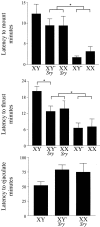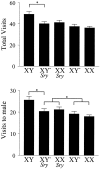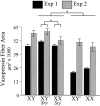A model system for study of sex chromosome effects on sexually dimorphic neural and behavioral traits
- PMID: 12388607
- PMCID: PMC6757680
- DOI: 10.1523/JNEUROSCI.22-20-09005.2002
A model system for study of sex chromosome effects on sexually dimorphic neural and behavioral traits
Abstract
We tested the hypothesis that genes encoded on the sex chromosomes play a direct role in sexual differentiation of brain and behavior. We used mice in which the testis-determining gene (Sry) was moved from the Y chromosome to an autosome (by deletion of Sry from the Y and subsequent insertion of an Sry transgene onto an autosome), so that the determination of testis development occurred independently of the complement of X or Y chromosomes. We compared XX and XY mice with ovaries (females) and XX and XY mice with testes (males). These comparisons allowed us to assess the effect of sex chromosome complement (XX vs XY) independent of gonadal status (testes vs ovaries) on sexually dimorphic neural and behavioral phenotypes. The phenotypes included measures of male copulatory behavior, social exploration behavior, and sexually dimorphic neuroanatomical structures in the septum, hypothalamus, and lumbar spinal cord. Most of the sexually dimorphic phenotypes correlated with the presence of ovaries or testes and therefore reflect the hormonal output of the gonads. We found, however, that both male and female mice with XY sex chromosomes were more masculine than XX mice in the density of vasopressin-immunoreactive fibers in the lateral septum. Moreover, two male groups differing only in the form of their Sry gene showed differences in behavior. The results show that sex chromosome genes contribute directly to the development of a sex difference in the brain.
Figures








Similar articles
-
Independent contribution of gonads and sex chromosomes to sex differences in bone mass and strength in the four-core genotypes mouse model.J Bone Miner Res. 2024 Oct 29;39(11):1659-1672. doi: 10.1093/jbmr/zjae147. J Bone Miner Res. 2024. PMID: 39255371
-
Sex chromosome complement and gonadal sex influence aggressive and parental behaviors in mice.J Neurosci. 2006 Feb 22;26(8):2335-42. doi: 10.1523/JNEUROSCI.3743-05.2006. J Neurosci. 2006. PMID: 16495461 Free PMC article.
-
Four core genotypes mouse model: localization of the Sry transgene and bioassay for testicular hormone levels.BMC Res Notes. 2015 Mar 7;8:69. doi: 10.1186/s13104-015-0986-2. BMC Res Notes. 2015. PMID: 25870930 Free PMC article.
-
Are XX and XY brain cells intrinsically different?Trends Endocrinol Metab. 2004 Jan-Feb;15(1):6-11. doi: 10.1016/j.tem.2003.11.001. Trends Endocrinol Metab. 2004. PMID: 14693420 Review.
-
What does the "four core genotypes" mouse model tell us about sex differences in the brain and other tissues?Front Neuroendocrinol. 2009 Jan;30(1):1-9. doi: 10.1016/j.yfrne.2008.11.001. Epub 2008 Nov 11. Front Neuroendocrinol. 2009. PMID: 19028515 Free PMC article. Review.
Cited by
-
Four Core Genotypes mice harbour a 3.2MB X-Y translocation that perturbs Tlr7 dosage.Nat Commun. 2024 Oct 11;15(1):8814. doi: 10.1038/s41467-024-52640-8. Nat Commun. 2024. PMID: 39394207 Free PMC article.
-
Effects of Congenital Adrenal Hyperplasia (CAH) and Biological Sex on Brain Size.Anatomia. 2024 Sep;3(3):155-162. doi: 10.3390/anatomia3030012. Epub 2024 Jul 18. Anatomia. 2024. PMID: 39391581
-
Revisiting sex as a biological variable in hypertension research.J Clin Invest. 2024 Sep 3;134(17):e180078. doi: 10.1172/JCI180078. J Clin Invest. 2024. PMID: 39225093 Free PMC article. Review.
-
Sex chromosomes and hormones independently influence healthy brain development but act similarly after cranial radiation.Proc Natl Acad Sci U S A. 2024 Sep 3;121(36):e2404042121. doi: 10.1073/pnas.2404042121. Epub 2024 Aug 29. Proc Natl Acad Sci U S A. 2024. PMID: 39207735
-
The relationship between gender and pharmacology.Curr Res Pharmacol Drug Discov. 2024 Jun 18;7:100192. doi: 10.1016/j.crphar.2024.100192. eCollection 2024. Curr Res Pharmacol Drug Discov. 2024. PMID: 39101002 Free PMC article.
References
-
- Abercrombie M. An estimation of nuclear population from microtomic sections. Anat Rec. 1946;94:239–247. - PubMed
-
- Agulnik AI, Mitchell MJ, Lerner JL, Woods DR, Bishop CE. A mouse Y chromosome gene encoded by a region essential for spermatogenesis and expression of male-specific minor histocompatibility antigens. Hum Mol Genet. 1994;3:873–878. - PubMed
-
- Arnold AP. Experimental analysis of sexual differentiation of the zebra finch brain. Brain Res Bull. 1997;44:503–507. - PubMed
-
- Arnold AP. Concepts of genetic and hormonal induction of vertebrate sexual differentiation in the 20th century, with special reference to the brain. In: Pfaff DW, Arnold AP, Etgen AM, Fahrbach SE, Moss RL, Rubin RT, editors. Hormones, brain, and behavior, Vol IV. Development of hormone-dependent neuronal systems. Academic; San Diego: 2002. pp. 105–135.
-
- Arnold AP, Gorski RA. Gonadal steroid induction of structural sex differences in the CNS. Annu Rev Neurosci. 1984;7:413–442. - PubMed
Publication types
MeSH terms
Substances
Grants and funding
LinkOut - more resources
Full Text Sources
Molecular Biology Databases
